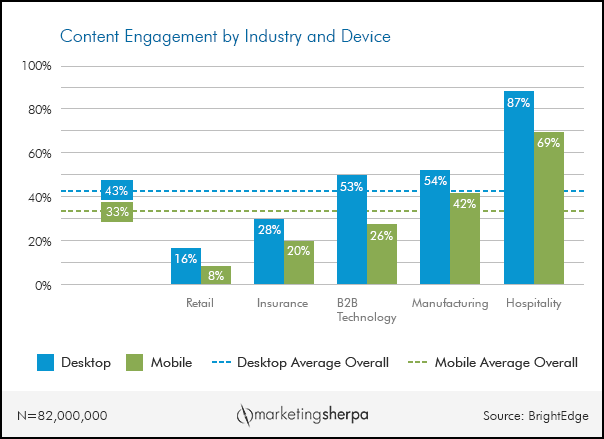by
Dr. Liva LaMontagne , Editorial Research Manager
In August 2015, BrightEdge released the results of a study of content engagement based on 82 million pieces of data from its Web-wide repository of content, rich media, search terms and social signals. It analyzed all written and visual content on websites, excluding ads.
Content engagement was estimated by an algorithm considering three types of metrics:
- Consumer interest metrics like traffic and time spent on page
- Metrics found further down the funnel like conversion rate and revenue driven by content
- Social engagement metrics like shares, likes and clicks from social channels
The report showed that engagement rates vary across industries but hover between 33 percent on mobile and 43 percent on desktop overall.

Click here to see a printable version of this chart
The highest content rates both on desktop and mobile were found in the hospitality industry, represented mostly by hotels. Retail had the lowest rates with 16% on desktop and 8% on mobile. Manufacturing and B2B technology had above-average engagement rates on desktop, but only manufacturing kept above-average rates on mobile in addition to desktop.
What are marketers in those above-average engagement industries doing right? How can marketers create content that customers engage with? Brad Mattick, Vice President of Marketing and Products, BrightEdge, shared the following insights.
Communicating on a small scale
Mattick mentioned that one of the most surprising findings was manufacturing’s relatively high rate of content engagement. He said this could largely be attributed to the fact that the majority of manufacturers do not sell to the mass market. Instead, they sell through a small group of distributors.
"For example, a hardware company could theoretically sell 95 percent of its product through five distributors. Because of this model, these companies can be hypertargeted to their customer base and thus drive [the] overall engagement rate up," Mattick said.
Similarly, in the hospitality industry which had the highest engagement numbers, content was highly targeted to customers’ interests.
"Much of their digital content is produced to describe specific, physical hotel rooms," Mattick said, adding that customers are looking at those rooms because they are interested in booking them.
The notion of personalized, relevant content isn’t new. Jayson DeMers wrote in his 2014 Harvard Business Review article, "Why No One’s Reading Your Marketing Content":
"Personalization — whether it’s based on interests, demographics or where customers are in their journey — gets you noticed and persuades people to take action. The more relevant your content is to them, the more effective it will be."
Differences in engagement between devices
Mattick explained the differences in mobile engagement across these five industries with the ways in which consumers access each industry’s content. For example, with retail, consumers generally spend more time shopping and making purchases on desktop devices and use mobile for quicker, less engagement-rich reasons (such as finding the location or hours of their local brick-and-mortar store).
Mattick pointed out that overall, the lower engagement on mobile is an opportunity for marketers to improve the quality of their mobile content. He added that, according to the 2014 BrightEdge Mobile Share Report, more than one in four mobile sites is misconfigured in some way, resulting in an average 68 percent loss of smartphone traffic to that content.
Key takeaways
As a marketer you can increase your customers’ overall engagement with your content by knowing your audience, ensuring the content is relevant to their needs and making it functionally accessible on their customers’ device of choice.
To the deeper point of creating relevant content, Joe Pulizzi, Founder and CEO, Content Marketing Institute, wrote in his book,
Content Inc.: How Entrepreneurs Use Content to Build Massive Audiences and Create Radically Successful Businesses, "Get laser-focused. Think of yourself as the trade magazine for your industry. Cover that. Be the expert in that area. If you are a large enterprise, you will need separate content strategies, not a broad one that makes no impact on anybody."
Related Resources
Subscribe to MarketingSherpa Chart of the Week — Get data and discoveries delivered to your inbox
Content Engagement Report (from BrightEdge)
Content Inc. (by Joe Pulizzi)
Inbound Marketing: How focusing on customer stories saw a 35% increase in content engagementWhy No One’s Reading Your Marketing Content (by Jayson DeMers, Harvard Business Review)
Content Marketing 101: Tips on content strategy [from MarketingSherpa blog]
Get inspired by content and social marketing case studies at the
MarketingSherpa Summit 2016 in Las Vegas










